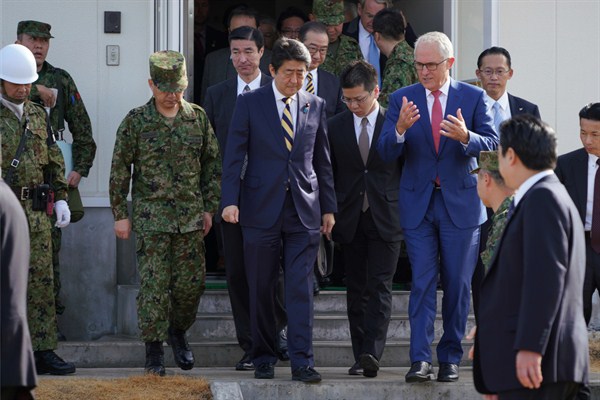Last month, Australian Prime Minister Malcolm Turnbull traveled to Japan for what has become an annual summit with Japanese Prime Minister Shinzo Abe, highlighting the sustained growth of strategic relations between Tokyo and Canberra. During the visit, both sides agreed on the importance of working together in the Indo-Pacific and combining their shared interests in the rule of law and the freedom of navigation—a signal toward China, with its increasingly aggressive claims in the South China Sea, and the United States, at a time when the Trump administration has raised unfamiliar questions about America’s position in Asia. In a joint statement, Turnbull and Abe noted their “commitment to enhancing their coordination and cooperation and to aligning their respective efforts, both bilaterally and in partnership with like-minded countries, to realize this vision for the region.”
The growth of the Japan-Australia relationship, especially over security, is not a sudden development, as ties have been increasing step by step over the past decade. That has led to an uptick in high-level exchanges and meetings between diplomats and defense officials in recent years. Later this year, Japan and Australia will conduct their 8th annual dialogue between ministers of foreign affairs and defense, the so-called 2+2. In diplomatic terms, the “2+2” arrangement is a positive baseline for countries to increase their level of discussion beyond cosmetic terms and with greater strategic purpose.
Japan and Australia have used this dialogue as the diplomatic venue for the more concrete and incremental growth of their security ties. One of the key takeaways of Turnbull’s January visit to Japan was progress toward the completion of a bilateral visiting forces agreement. While there was some hope that the agreement might have been announced in January, there are still some issues to work out, though it is likely the deal will get done before the end of this year. The visiting forces agreement would allow both countries’ militaries to operate more freely in each other’s territory and improve the ability to conduct joint operations, resulting in what they hope is a more seamless security and defense partnership. In addition to the potential for smoother joint operations, the agreement would also allow Japan and Australia to quickly dispatch forces to the other’s territory in the event of a natural disaster. Some observers have called the potential agreement a further sign of Japan and Australia’s “quasi-alliance.”

